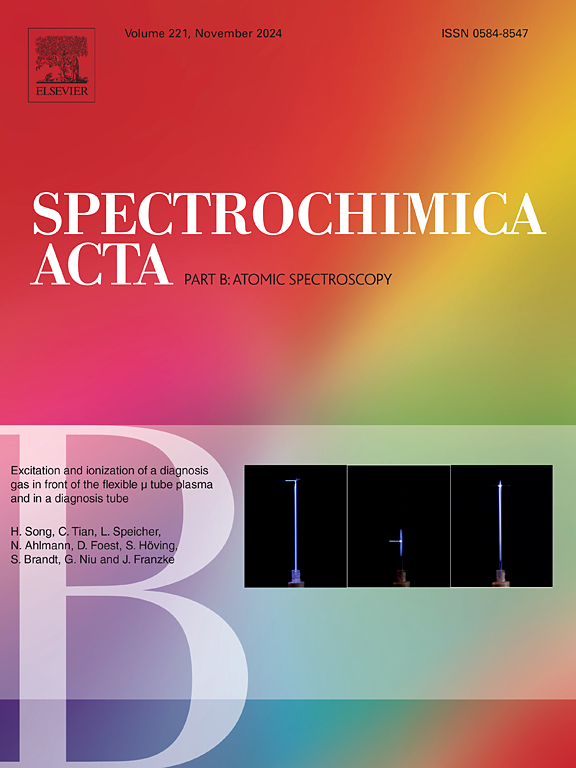激光能量对环形激光诱导等离子体光谱特性的影响
IF 3.8
2区 化学
Q1 SPECTROSCOPY
引用次数: 0
摘要
激光能量是影响LIBS分析性能的关键实验参数。为了研究环形光束形成的等离子体的特性,利用轴突将调q Nd:YAG激光器发射的高斯激光束转换成环形激光束。采用环形束对合金钢试样进行烧蚀,产生等离子体。研究了激光能量对环形等离子体光谱发射和空间演化特性的影响。结果表明,环形束与样品相互作用区域内材料的熔化比高斯束熔化区域内材料的熔化更为均匀。光谱线强度、等离子体温度和电子密度随激光能量的增加而增加。当能量超过145mj时,信号背景比(SBR)先快速增加,然后减慢。光谱强度的二维空间分布呈扁平状,沿等离子体的横向方向有两个峰,峰间的距离对应于环形烧蚀坑的大小。激光能量的增加使环形等离子体中心区域的膨胀速度加快,光谱线强度变化梯度减小。随着激光能量的增加,环形等离子体横向上的两个峰的位置逐渐远离中心。等离子体温度和电子密度的二维空间分布也说明了环形等离子体各区域之间的耦合,导致等离子体内部的区域更加均匀。本文章由计算机程序翻译,如有差异,请以英文原文为准。

Influence of laser energy on spectral properties of annular laser-induced plasma
Laser energy is a key experimental parameter affecting the analytical performance of LIBS. In order to investigate the characteristics of the plasma formed by an annular beam, an axicon was used to convert the Gaussian laser beam emitted from a Q-switched Nd:YAG laser into an annular laser beam. The annular beam was used to ablate the alloy steel sample to produce plasma. The influence of laser energy on the spectral emission and spatial evolution characteristics of the annular plasma was investigated. The results show that the melting of the material in the region where the annular beam interacts with the sample is more homogeneous than the melting material ablated by the Gaussian beam. The spectral line intensity, plasma temperature and electron density increase with the increase of the laser energy. The Signal-to-Background Ratio (SBR) increasing rapidly first, and then slowing down when the energy exceeds 145 mJ. The two-dimensional spatial distribution of the spectral intensity shows a flat shape, with two peaks along the transverse direction of the plasma, and the distance between the peaks corresponds to the size of the annular ablation crater. The increase in laser energy causes the faster expansion and the smaller gradient of the spectral line intensity change in the central region of the annular plasma. The positions of the two peaks along the transverse direction of the annular plasma are shifted away from the center with the increase of the laser energy. The two-dimensional spatial distribution of the plasma temperature and electron density also illustrates the coupling between the various regions of the annular plasma resulting in a more homogeneous region inside the plasma.
求助全文
通过发布文献求助,成功后即可免费获取论文全文。
去求助
来源期刊
CiteScore
6.10
自引率
12.10%
发文量
173
审稿时长
81 days
期刊介绍:
Spectrochimica Acta Part B: Atomic Spectroscopy, is intended for the rapid publication of both original work and reviews in the following fields:
Atomic Emission (AES), Atomic Absorption (AAS) and Atomic Fluorescence (AFS) spectroscopy;
Mass Spectrometry (MS) for inorganic analysis covering Spark Source (SS-MS), Inductively Coupled Plasma (ICP-MS), Glow Discharge (GD-MS), and Secondary Ion Mass Spectrometry (SIMS).
Laser induced atomic spectroscopy for inorganic analysis, including non-linear optical laser spectroscopy, covering Laser Enhanced Ionization (LEI), Laser Induced Fluorescence (LIF), Resonance Ionization Spectroscopy (RIS) and Resonance Ionization Mass Spectrometry (RIMS); Laser Induced Breakdown Spectroscopy (LIBS); Cavity Ringdown Spectroscopy (CRDS), Laser Ablation Inductively Coupled Plasma Atomic Emission Spectroscopy (LA-ICP-AES) and Laser Ablation Inductively Coupled Plasma Mass Spectrometry (LA-ICP-MS).
X-ray spectrometry, X-ray Optics and Microanalysis, including X-ray fluorescence spectrometry (XRF) and related techniques, in particular Total-reflection X-ray Fluorescence Spectrometry (TXRF), and Synchrotron Radiation-excited Total reflection XRF (SR-TXRF).
Manuscripts dealing with (i) fundamentals, (ii) methodology development, (iii)instrumentation, and (iv) applications, can be submitted for publication.

 求助内容:
求助内容: 应助结果提醒方式:
应助结果提醒方式:


